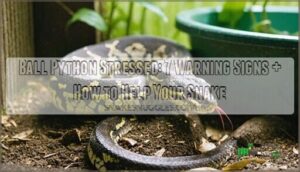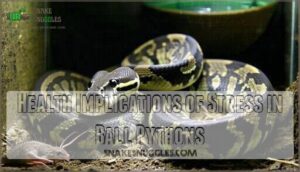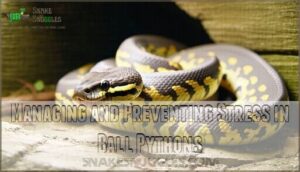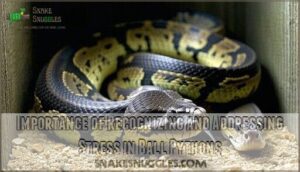This site is supported by our readers. We may earn a commission, at no cost to you, if you purchase through links.
 Your ball python stressed? You’ll notice key warning signs like refusing food, constant hiding, hissing, or defensive striking.
Your ball python stressed? You’ll notice key warning signs like refusing food, constant hiding, hissing, or defensive striking.
These behaviors aren’t just snake attitude – they’re red flags that something’s wrong in their environment.
Common stress triggers include wrong temperatures, inadequate hiding spots, too much handling, or poor enclosure setup.
When your python feels threatened, their immune system weakens, making them vulnerable to infections and health problems.
Think of stress like a slow leak in a tire – it doesn’t seem urgent until everything falls apart.
Fixing temperature gradients, providing secure hides, and limiting interaction can work wonders, but there’s more to creating the perfect stress-free sanctuary.
Creating an environment that minimizes stress is crucial for the health and well-being of your ball python, and it requires careful consideration of their needs and behaviors.
Table Of Contents
- Key Takeaways
- Signs of Stress in Ball Pythons
- How to Tell if a Ball Python is Stressed
- What Causes Stress in Ball Pythons
- Health Implications of Stress in Ball Pythons
- Managing and Preventing Stress in Ball Pythons
- Importance of Recognizing and Addressing Stress in Ball Pythons
- How to Destress a Ball Python
- Frequently Asked Questions (FAQs)
- How do I know if my ball python is stressed?
- How to destress a snake?
- How to calm a ball python down?
- How do I know if my ball python is impacted?
- How Do I Know if My Ball Python is Experiencing Stress?
- Is It Possible to Reduce Stress in Ball Pythons?
- What Kind of Environment is Best for a Ball Python?
- What Are Some Signs of Stress That I Should Look Out For?
- How Can I Make Sure My Ball Python is Healthy and Happy?
- Can stress affect a ball pythons breeding behavior?
- Conclusion
Key Takeaways
- Watch for clear warning signs – You’ll spot stress through hissing, striking, refusing food, constant hiding, or nose rubbing, which signal that your snake needs immediate environmental changes.
- Fix the environment first – You must maintain proper temperatures (78-92°F), humidity (50-60%), and provide multiple secure hiding spots on both the warm and cool sides of the enclosure.
- Limit handling dramatically – You should handle your ball python only once weekly for under 15 minutes, avoiding contact during shedding or after meals to prevent overwhelming them.
- Act quickly to prevent health problems – You cannot ignore stress because it weakens your snake’s immune system, leading to infections, wounds, and potentially life-threatening conditions that require expensive vet care.
Signs of Stress in Ball Pythons
Your ball python’s behavior tells you everything about its well-being, and stressed snakes show clear warning signs you can’t ignore.
Watch for hissing, striking, refusal to eat, head-hiding, and other defensive behaviors that signal your snake needs help.
Hissing
Hissing serves as your ball python’s primary alarm system when they’re feeling threatened or uncomfortable.
This defensive behavior isn’t just noise—it’s a clear communication that something’s wrong in their world. The hissing intensity and frequency can vary based on stress levels, with louder, more frequent sounds indicating higher distress.
Common triggers for hissing include:
- Environmental changes like new enclosure setups or relocated habitats
- Excessive handling that overwhelms your snake’s comfort zone
- Temperature fluctuations outside their preferred 78-92°F range
- Health issues causing internal discomfort or pain
Striking
When your ball python starts striking, you’re witnessing classic defensive behavior.
This snake aggression isn’t personal—it’s stress talking.
Strike frequency increases when they feel cornered, with strike accuracy surprisingly high despite their calm reputation.
Notice strike intensity and strike targets; they’re usually aiming to create distance, not harm.
Reduce handling and add hiding spots to calm your ball python stressed response naturally.
Biting
Defensive biting represents your ball python’s last resort when overwhelmed by stress. Though bite severity remains minimal due to their non-venomous nature, bite consequences include minor puncture wounds.
Handling risks increase dramatically with stressed snakes showing defensive behavior and snake aggression.
Key signs of defensive biting include:
- Snake coiling tightly before striking at your hand
- Rapid jerking movements when you approach the enclosure
- Lunging forward with mouth open during feeding time
- Freezing completely before sudden biting attempts
Bite prevention starts with recognizing your ball python stressed signals early, to mitigate the risk of defensive biting.
Head-Hiding
When your ball python buries its head while exposing its tail, you’re witnessing a classic defense mechanism.
This headhiding behavior signals your snake feels threatened or insecure. Head-hiding causes include poor enclosure security, wrong temperatures, or cage mates.
Snake anxiety drives this behavioral interpretation – your stressed ball python protects its most vulnerable part.
Frequent hiding frequency combined with other snake stress signs reveals your pet needs environmental adjustments for comfort.
Poor Appetite
When your ball python stressed shows poor appetite, it’s waving a red flag.
Appetite loss often signals underlying stress issues that need immediate attention. A ball python not eating for weeks indicates serious problems with feeding schedule, temperature, or habitat conditions.
Monitor their dietary needs and food preference carefully. Stress disrupts normal eating patterns, so check environmental factors first.
Elevated stress levels can also manifest physiologically, and for more information, you can visit Elevated stress levels.
Proper supplementation and consistent routines help restore healthy appetites in stressed pythons.
How to Tell if a Ball Python is Stressed
Reading your ball python’s stress signals requires close observation of their behavior and body language.
You’ll notice changes in eating habits, defensive postures, and physical reactions that clearly indicate when your snake feels uncomfortable or threatened, which can be understood by recognizing complete concepts and stress signals.
Lack of Appetite
When your ball python not eating becomes a pattern, it’s a red flag for stress.
Poor appetite signals something’s wrong in their world. This appetite loss can last weeks if underlying causes aren’t addressed.
- Temperature issues – Wrong heat levels affect digestion
- Humidity problems – Dry air creates discomfort
- Handling stress – Too much interaction overwhelms them
- Underlying illness – Health problems reduce food preferences
Change in Body Language
Three key stress indicators reveal your snake’s discomfort through body language.
Freezing behavior shows your python evaluating threats, while tail wagging outside feeding time signals anxiety.
Watch for tense posture, escape attempts along enclosure walls, and constricting objects unnecessarily.
One key physiological sign can be elevated heart rate, indicating the activation of their sympathetic nervous system.
These snake stress signs help you identify ball python stress early, allowing quick environmental adjustments before stress indicators worsen.
Hissing as a Stress Sign
When your python stress signs include loud hissing, pay attention to the context and frequency.
A stressed ball python will hiss more often and with greater intensity than normal. This snake stress symptom signals discomfort with their environment or handling.
Watch for these hissing variations that indicate stress:
- Hissing volume increases during high-stress situations
- Hissing frequency becomes more common throughout the day
- Hissing intensity escalates when you approach the enclosure
Defensive Striking
When your stressed ball python starts striking, it’s showing you pure fear.
This python stress sign means they see you as a threat.
Ball python behavior like this happens when snake stress symptoms build up.
Watch for striking frequency and strike accuracy – both increase under stress.
Strike force also intensifies when they’re defensive.
| Striking Triggers | Physical Signs |
|---|---|
| Sudden movements | Coiled position |
| Loud noises | Flattened head |
| Handling attempts | Tensed muscles |
Reducing strikes requires patience and proper care.
What Causes Stress in Ball Pythons
Your ball python’s stress often comes from problems you can fix in their environment.
Poor temperature control, wrong humidity levels, too much handling, or sharing space with another snake creates the perfect recipe for an anxious reptile, as these factors contribute to their overall well-being, and fixing them can help alleviate stress.
Environmental Factors
Your ball python’s habitat can make or break its well-being.
Environmental stressors create lasting anxiety that affects your snake’s health and behavior.
Key factors that impact your snake environment include:
- Enclosure Size – Too small restricts movement and increases stress
- Temperature Gradient – Must range 75-95°F for proper thermoregulation
- Humidity Levels – Keep between 50-60% for respiratory health
- Hiding Spots – Multiple secure areas reduce perceived threats
- Lighting Needs – Minimal direct light mimics natural habitat conditions
Understanding appropriate housing systems is essential for a ball python’s well-being.
Poor habitat quality undermines your python’s sense of security completely.
Handling Frequency
Your handling techniques can make or break your snake’s comfort level. Overhandling ranks among the top stressors for ball pythons. Even well-meaning owners can trigger a stressed ball python through excessive interaction.
Every snake has individual preferences regarding contact. Some tolerate brief sessions while others prefer minimal handling. Forced handling never works and often backfires. Snake temperament varies substantially between individuals.
Follow these guidelines for stress-free snake handling:
- Limit handling duration to 10-15 minutes maximum
- Wait 48 hours between sessions
- Avoid handling during shedding or after meals
- Respect your ball python stress signals immediately
Your python’s body language tells you everything you need to know. It is crucial to understand and respond to their body language to ensure a healthy and happy pet. By doing so, you can provide the best possible care and create a strong bond with your ball python, ensuring their well-being and your peace of mind.
Enclosure Setup
Your enclosure setup directly impacts your snake’s stress levels. Enclosure Size matters – too small creates anxiety, while too large feels overwhelming.
Establish a proper Temperature Gradient from 88-92°F on the warm side to 78-80°F on the cool side. Maintain Humidity Control between 50-60% to prevent respiratory issues.
Provide multiple Hiding Spots – one warm, one cool. Choose appropriate Substrate Choice like cypress mulch or paper towels.
A proper setup includes essential enclosure products. Poor enclosure setup creates a stressed ball python quickly.
Sharing Enclosure
Ball pythons thrive as solitary species, so sharing a cage brings significant cohabitation risks.
These snakes aren’t social and may display dominance behavior or resource competition, leading to stress. A stressed ball python might refuse food, hide excessively, or even strike.
Here’s why cohabitation is problematic:
- Limited space increases tension and territorial disputes.
- Dominance behavior can cause injury or fear.
- Resource competition over hides or food creates anxiety.
- Stress reduction becomes nearly impossible in shared enclosures.
To guarantee their well-being, always house ball pythons individually.
Health Issues
Underlying python health problems create a vicious cycle of stress that’s hard to break.
Respiratory problems from poor air quality trigger elevated corticosterone levels, your snake’s stress hormone.
Nose rubbing against enclosure walls often signals discomfort from shedding issues or skin irritation.
Appetite loss becomes concerning when it persists beyond normal fasting periods.
These health issues weaken your ball python’s immune system through immune suppression, making recovery slower.
Regular health monitoring prevents minor problems from becoming major snake stress triggers.
Maintaining proper humidity is essential to avoid common shedding issues.
Health Implications of Stress in Ball Pythons
Stress doesn’t just make your ball python uncomfortable—it weakens their immune system and opens the door to serious health problems.
When stress goes untreated, your snake can develop infections, wounds from nose rubbing, and even life-threatening conditions that require immediate veterinary care, which can be a result of prolonged stress.
Weakening of The Immune System
Chronic stress acts like a thief, stealing your ball python’s natural defenses.
Stress silently robs your ball python of its strength, leaving it defenseless against disease and infection.
When stress hormones flood their system, your snake’s immune system weakens substantially.
This creates a domino effect that compromises their overall health and leaves them vulnerable to various illnesses.
- Infection susceptibility increases dramatically when stress hormones suppress white blood cells
- Lymphocyte function becomes impaired, reducing the body’s ability to fight off diseases
- Gut microbiome balance shifts, affecting digestion and nutrient absorption
- Autoimmune disease risk rises as the confused immune system attacks healthy tissue
- Snake health deteriorates rapidly without proper immune system support
Potential for Severe Consequences
Most stress cases in ball pythons won’t kill your snake outright, but Fatal Outcomes become real when stress turns chronic.
Organ Failure can develop from prolonged Immune Suppression, while Reduced Lifespan becomes inevitable without Veterinary Intervention.
Don’t let ball python stress escalate into life-threatening health issues.
| Stress Duration | Health Risk Level | Potential Consequences |
|---|---|---|
| 1-2 weeks | Low | Appetite loss, hiding |
| 1-2 months | Moderate | Weight loss, weakened immunity |
| 3+ months | High | Organ dysfunction, infections |
| 6+ months | Severe | Permanent damage, death |
Wounds and Infections
When your ball python’s immune system weakens from stress, minor injuries become major problems.
Wounds and abscesses develop more easily, and bacteria find easy entry points. Scale rot can spread quickly across compromised skin.
Without proper wound care and preventative hygiene, these snake infections turn dangerous fast.
Septicemia risks increase dramatically when stress leaves your snake vulnerable. What starts as a small scrape can become a life-threatening infection.
Regular health checks help you spot trouble early. Clean enclosures and proper abscess treatment prevent minor issues from becoming fatal snake health issues.
Quick action saves lives.
Managing and Preventing Stress in Ball Pythons
You can prevent most stress in your ball python by setting up the right environment and handling practices.
Focus on proper temperature, humidity, hiding spots, and minimal handling to keep your snake calm and healthy.
Proper Enclosure Setup
Setting up your ball python’s home correctly prevents most stress issues. Enclosure Size matters – adults need at least 4 feet long by 2 feet wide.
Create a Temperature Gradient with one warm side and one cool side. Maintain Humidity Control between 50-60% using a reliable hygrometer.
Choose moisture-retaining Substrate Choice like cypress mulch or coco coir. Add multiple Hiding Spots on both warm and cool sides.
Many keepers purchase a complete python habitat for convenience. This proper enclosure setup creates optimal habitat conditions that keep your snake comfortable and stress-free.
Limited Handling
Overhandling tops the list of ball python stress triggers. Your snake’s personality and acclimation period determine their tolerance levels.
Minimal interaction prevents stress indicators from surfacing.
- Limit handling frequency to once weekly maximum
- Keep sessions brief – under 15 minutes prevents overwhelm
- Skip handling during shedding or post-meal digestion periods
- Adjust owner expectations based on your snake’s comfort signals
Promoting Security
Beyond reducing hands-on contact, your snake needs a fortress of comfort to thrive. Creating secure hides throughout the enclosure gives your ball python essential refuge spots. Place at least two snug hiding places—one on each temperature zone.
This enclosure enrichment mimics their natural habitat and provides instant stress relief when they feel vulnerable. To further minimize stress, remember to wash your hands thoroughly before handling.
Establish a consistent routine for feeding and maintenance. Gradual acclimation to any changes prevents shock. Your snake’s comfort depends on predictable patterns and safe spaces.
| Security Feature | Benefit |
|---|---|
| Multiple hiding places | Reduces anxiety |
| Consistent routine | Builds trust |
| Gradual changes | Prevents stress spikes |
Your snake will benefit from a well-structured environment that includes multiple hiding places, a consistent routine, and gradual changes to prevent shock, ultimately leading to a comfortable life.
Importance of Recognizing and Addressing Stress in Ball Pythons
Understanding stress signals in your ball python can prevent serious health problems and create a better life for your pet.
When you catch stress early and fix the causes, you’ll keep your snake healthy and avoid costly vet visits down the road, which can help prevent serious health problems and create a better life.
Creates a Safe Environment
Why does your ball python need a stress-free sanctuary? Creating the right environment prevents ball python stress from escalating into serious health problems.
When you address environmental factors early, you’re building a foundation for your snake’s wellbeing.
Here’s how proper setup creates safety:
- Secure Hides and hiding places offer stress relief when your snake feels vulnerable
- Temperature Gradient and Humidity Control maintain ideal conditions for comfort
- Enclosure Enrichment with Proper Substrate reduces anxiety-triggering factors
Reduces Stress Levels
Creating the right environment actively reduces ball python stress levels through targeted stress management techniques.
Proper acclimation to new surroundings helps your snake adjust naturally. Secure hides provide essential comfort zones where your python feels protected.
Consistent handling techniques build trust without overwhelming your pet. Regular veterinary checkups catch stress-related issues early.
Enrichment activities like varied climbing branches promote natural behaviors. These stress reduction strategies work together, transforming an anxious snake into a relaxed, thriving companion through improved ball python welfare.
Prevents Long-term Problems
Reducing stress levels now prevents serious ball python stress complications later.
Early intervention stops minor issues from becoming major health crises.
Your snake’s future depends on today’s stress management decisions.
Preventing long-term problems through proactive care includes:
- Veterinary consultation when stress signs appear
- Habitat enrichment with proper hiding spots
- Secure environment maintenance year-round
- Gradual acclimation during any changes
How to Destress a Ball Python
Several effective destressing techniques can help your ball python return to its calm, natural state. Start by examining your snake’s environment and making necessary habitat improvements.
Here are three essential steps to reduce ball python stress:
- Temperature and humidity control – Maintain 80-85°F on the warm side with 50-60% humidity levels
- Enrichment ideas – Add multiple hiding spots, fake plants, and branches to create security
- Quiet placement – Move the enclosure away from high-traffic areas and loud noises
Limit handling techniques during recovery periods. Your snake needs time to decompress without additional stimulation. Diet adjustments aren’t usually necessary unless feeding problems persist.
If destressing techniques don’t work within two weeks, schedule vet consultations. A reptile veterinarian can identify underlying health issues causing ongoing snake stress. Remember, ball python care requires patience – some snakes need several weeks to fully relax in their environment. Consider how sudden movements impact stress and handle your snake accordingly.
Frequently Asked Questions (FAQs)
How do I know if my ball python is stressed?
You’ll notice stress through defensive behaviors like hissing, striking, or balling up tightly.
Watch for appetite loss, excessive hiding, nose rubbing, escape attempts, and changes in activity levels or breathing patterns, which can indicate stress.
How to destress a snake?
Like a worried pet finding its safe haven, you’ll create calm by checking your snake’s temperature and humidity levels.
Providing hiding spots, reducing handling, and ensuring a quiet environment away from disturbances.
How to calm a ball python down?
Give your ball python space and time to settle.
Don’t handle them for at least a week.
Check their enclosure has proper temperature, humidity, and hiding spots.
Keep noise levels low around their habitat, this will help them to settle.
How do I know if my ball python is impacted?
Look for constipation lasting over two weeks, bloating in the lower body, straining without defecating, loss of appetite, and lethargy.
Your snake may also show discomfort when touched near the abdomen area.
How Do I Know if My Ball Python is Experiencing Stress?
Your scaly friend isn’t feeling their best when they’re coiled tight, refusing meals, or rubbing their nose raw.
Watch for hissing, hiding constantly, or attempting escape routes—these signals mean something’s wrong.
Is It Possible to Reduce Stress in Ball Pythons?
Yes, you can definitely reduce stress in your ball python.
Fix temperature and humidity levels, provide proper hiding spots, minimize handling, maintain clean enclosures, and create a quiet environment for maximum comfort.
What Kind of Environment is Best for a Ball Python?
Home is where the heart is, and your ball python needs proper warmth, humidity, and hiding spots.
Maintain temperatures between 78-92°F, humidity at 50-60%, and provide secure hides for comfort.
What Are Some Signs of Stress That I Should Look Out For?
Watch for hissing, striking, or biting behaviors.
Your snake might refuse food, hide excessively, or rub its nose against walls.
Escape attempts, tight coiling, and freezing without tongue-flicking also signal stress needing attention.
How Can I Make Sure My Ball Python is Healthy and Happy?
Think your ball python’s automatically happy in captivity? Not quite.
You’ll need proper temperature (78-92°F), humidity (50-60%), adequate hiding spots, appropriate enclosure size, and minimal handling to keep your snake truly healthy and content. Proper temperature is key.
Can stress affect a ball pythons breeding behavior?
Stress substantially disrupts your ball python’s breeding behavior.
Stressed females won’t ovulate properly, males lose interest in mating, and both sexes may refuse food during breeding season, making successful reproduction nearly impossible.
Conclusion
Remember, your ball python’s enclosure is their entire world – make it count.
When you spot signs that your ball python is stressed, don’t wait for problems to escalate.
Quick action saves your snake from serious health issues.
Focus on proper temperatures, secure hiding spots, and minimal handling.
Your python will reward your efforts with calm behavior and steady eating habits.
A stress-free snake is a healthy snake, and prevention always beats treatment.




















